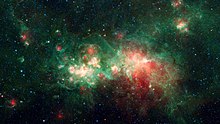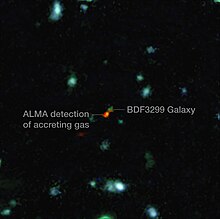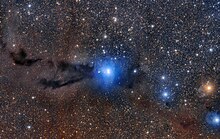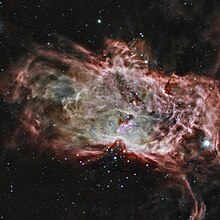Star formation

Star formation is the process by which dense regions within
Stellar nurseries
Interstellar clouds

In the dense nebulae where stars are produced, much of the hydrogen is in the molecular (H2) form, so these nebulae are called molecular clouds.[4] The Herschel Space Observatory has revealed that filaments, or elongated dense gas structures, are truly ubiquitous in molecular clouds and central to the star formation process. They fragment into gravitationally bound cores, most of which will evolve into stars. Continuous accretion of gas, geometrical bending[definition needed], and magnetic fields may control the detailed manner in which the filaments are fragmented. Observations of supercritical filaments have revealed quasi-periodic chains of dense cores with spacing comparable to the filament inner width, and embedded protostars with outflows.[jargon][6]
Observations indicate that the coldest clouds tend to form low-mass stars, which are first observed via the infrared light they emit inside the clouds, and then as visible light when the clouds dissipate. Giant molecular clouds, which are generally warmer, produce stars of all masses.[7] These giant molecular clouds have typical densities of 100 particles per cm3, diameters of 100 light-years (9.5×1014 km), masses of up to 6 million solar masses (M☉), or six million times the mass of Earth's sun.[8] The average interior temperature is 10 K (−441.7 °F).
About half the total mass of the Milky Way's galactic ISM is found in molecular clouds[9] and the galaxy includes an estimated 6,000 molecular clouds, each with more than 100,000 M☉.[10] The nebula nearest to the Sun where massive stars are being formed is the Orion Nebula, 1,300 light-years (1.2×1016 km) away.[11] However, lower mass star formation is occurring about 400–450 light-years distant in the ρ Ophiuchi cloud complex.[12]
A more compact site of star formation is the opaque clouds of dense gas and dust known as Bok globules, so named after the astronomer Bart Bok. These can form in association with collapsing molecular clouds or possibly independently.[13] The Bok globules are typically up to a light-year across and contain a few solar masses.[14] They can be observed as dark clouds silhouetted against bright emission nebulae or background stars. Over half the known Bok globules have been found to contain newly forming stars.[15]

Cloud collapse
An interstellar cloud of gas will remain in

In triggered star formation, one of several events might occur to compress a molecular cloud and initiate its
A

As it collapses, a molecular cloud breaks into smaller and smaller pieces in a hierarchical manner, until the fragments reach stellar mass. In each of these fragments, the collapsing gas radiates away the energy gained by the release of
Complicating this picture of a collapsing cloud are the effects of
Protostar

A protostellar cloud will continue to collapse as long as the gravitational binding energy can be eliminated. This excess energy is primarily lost through radiation. However, the collapsing cloud will eventually become opaque to its own radiation, and the energy must be removed through some other means. The dust within the cloud becomes heated to temperatures of 60–100 K, and these particles radiate at wavelengths in the far infrared where the cloud is transparent. Thus the dust mediates the further collapse of the cloud.[29]
During the collapse, the density of the cloud increases towards the center and thus the middle region becomes optically opaque first. This occurs when the density is about 10−13 g / cm3. A core region, called the first hydrostatic core, forms where the collapse is essentially halted. It continues to increase in temperature as determined by the virial theorem. The gas falling toward this opaque region collides with it and creates shock waves that further heat the core.[30]
When the core temperature reaches about 2000 K, the thermal energy dissociates the H2 molecules.[30] This is followed by the ionization of the hydrogen and helium atoms. These processes absorb the energy of the contraction, allowing it to continue on timescales comparable to the period of collapse at free fall velocities.[31] After the density of infalling material has reached about 10−8 g / cm3, that material is sufficiently transparent to allow energy radiated by the protostar to escape. The combination of convection within the protostar and radiation from its exterior allow the star to contract further.[30] This continues until the gas is hot enough for the internal pressure to support the protostar against further gravitational collapse—a state called hydrostatic equilibrium. When this accretion phase is nearly complete, the resulting object is known as a protostar.[4]

Accretion of material onto the protostar continues partially from the newly formed circumstellar disc. When the density and temperature are high enough, deuterium fusion begins, and the outward pressure of the resultant radiation slows (but does not stop) the collapse. Material comprising the cloud continues to "rain" onto the protostar. In this stage bipolar jets are produced called Herbig–Haro objects. This is probably the means by which excess angular momentum of the infalling material is expelled, allowing the star to continue to form.

When the surrounding gas and dust envelope disperses and accretion process stops, the star is considered a pre-main-sequence star (PMS star). The energy source of these objects is (gravitational contraction)Kelvin–Helmholtz mechanism, as opposed to hydrogen burning in main sequence stars. The PMS star follows a Hayashi track on the Hertzsprung–Russell (H–R) diagram.[33] The contraction will proceed until the Hayashi limit is reached, and thereafter contraction will continue on a Kelvin–Helmholtz timescale with the temperature remaining stable. Stars with less than 0.5 M☉ thereafter join the main sequence. For more massive PMS stars, at the end of the Hayashi track they will slowly collapse in near hydrostatic equilibrium, following the Henyey track.[34]
Finally, hydrogen begins to fuse in the core of the star, and the rest of the enveloping material is cleared away. This ends the protostellar phase and begins the star's main sequence phase on the H–R diagram.
The stages of the process are well defined in stars with masses around 1 M☉ or less. In high mass stars, the length of the star formation process is comparable to the other timescales of their evolution, much shorter, and the process is not so well defined. The later evolution of stars is studied in stellar evolution.
| Protostar |
|---|

Protostar outburst - HOPS 383 (2015).
|
Observations

Key elements of star formation are only available by observing in

The structure of the molecular cloud and the effects of the protostar can be observed in near-IR extinction maps (where the number of stars are counted per unit area and compared to a nearby zero extinction area of sky), continuum dust emission and rotational transitions of CO and other molecules; these last two are observed in the millimeter and submillimeter range. The radiation from the protostar and early star has to be observed in infrared astronomy wavelengths, as the extinction caused by the rest of the cloud in which the star is forming is usually too big to allow us to observe it in the visual part of the spectrum. This presents considerable difficulties as the Earth's atmosphere is almost entirely opaque from 20μm to 850μm, with narrow windows at 200μm and 450μm. Even outside this range, atmospheric subtraction techniques must be used.

The formation of individual stars can only be directly observed in the Milky Way Galaxy, but in distant galaxies star formation has been detected through its unique spectral signature.
Initial research indicates star-forming clumps start as giant, dense areas in turbulent gas-rich matter in young galaxies, live about 500 million years, and may migrate to the center of a galaxy, creating the central bulge of a galaxy.[47]
On February 21, 2014, NASA announced a greatly upgraded database for tracking polycyclic aromatic hydrocarbons (PAHs) in the universe. According to scientists, more than 20% of the carbon in the universe may be associated with PAHs, possible starting materials for the formation of life. PAHs seem to have been formed shortly after the Big Bang, are widespread throughout the universe, and are associated with new stars and exoplanets.[48]
In February 2018, astronomers reported, for the first time, a signal of the reionization epoch, an indirect detection of light from the earliest stars formed - about 180 million years after the Big Bang.[49]
An article published on October 22, 2019, reported on the detection of 3MM-1, a massive star-forming galaxy about 12.5 billion light-years away that is obscured by clouds of dust.[50] At a mass of about 1010.8 solar masses, it showed a star formation rate about 100 times as high as in the Milky Way.[51]
Notable pathfinder objects
- MWC 349 was first discovered in 1978, and is estimated to be only 1,000 years old.
- VLA 1623 – The first exemplar Class 0 protostar, a type of embedded protostar that has yet to accrete the majority of its mass. Found in 1993, is possibly younger than 10,000 years.[52]
- L1014 – An extremely faint embedded object representative of a new class of sources that are only now being detected with the newest telescopes. Their status is still undetermined, they could be the youngest low-mass Class 0 protostars yet seen or even very low-mass evolved objects (like brown dwarfs or even rogue planets).[53]
- GCIRS 8* – The youngest known main sequence star in the Galactic Center region, discovered in August 2006. It is estimated to be 3.5 million years old.[54]
Low mass and high mass star formation
Stars of different masses are thought to form by slightly different mechanisms. The theory of low-mass star formation, which is well-supported by observation, suggests that low-mass stars form by the gravitational collapse of rotating density enhancements within molecular clouds. As described above, the collapse of a rotating cloud of gas and dust leads to the formation of an accretion disk through which matter is channeled onto a central protostar. For stars with masses higher than about 8 M☉, however, the mechanism of star formation is not well understood.
Massive stars emit copious quantities of radiation which pushes against infalling material. In the past, it was thought that this radiation pressure might be substantial enough to halt accretion onto the massive protostar and prevent the formation of stars with masses more than a few tens of solar masses.[57] Recent theoretical work has shown that the production of a jet and outflow clears a cavity through which much of the radiation from a massive protostar can escape without hindering accretion through the disk and onto the protostar.[58][59] Present thinking is that massive stars may therefore be able to form by a mechanism similar to that by which low mass stars form.
There is mounting evidence that at least some massive protostars are indeed surrounded by accretion disks.[60] Disk accretion in high-mass protostars, similar to their low-mass counterparts, is expected to exhibit bursts of episodic accretion as a result of a gravitationally instability leading to clumpy and in-continuous accretion rates. Recent evidence of accretion bursts in high-mass protostars has indeed been confirmed observationally.[60][61][62] Several other theories of massive star formation remain to be tested observationally. Of these, perhaps the most prominent is the theory of competitive accretion, which suggests that massive protostars are "seeded" by low-mass protostars which compete with other protostars to draw in matter from the entire parent molecular cloud, instead of simply from a small local region.[63][64]
Another theory of massive star formation suggests that massive stars may form by the coalescence of two or more stars of lower mass.[65]
See also
- Accretion – Accumulation of particles into a massive object by gravitationally attracting more matter
- Champagne flow model
- Chronology of the universe – History and future of the universe
- Formation and evolution of the Solar System – Modelling its structure and composition
- Galaxy formation and evolution – From a homogeneous beginning, the formation of the first galaxies, the way galaxies change over time
- List of star-forming regions in the Local Group – Regions in the Milky Way galaxy and Local Group where new stars are forming
- Pea galaxy – Possible type of luminous blue compact galaxy
References
- ISBN 3-527-40559-3.
- S2CID 16752089.
- ^ O'Dell, C. R. "Nebula". World Book at NASA. World Book, Inc. Archived from the original on 2005-04-29. Retrieved 2009-05-18.
- ^ ISBN 0-521-65065-8.
- Bibcode:1991IAUS..146..373D.
- S2CID 211126855.
- ISBN 978-981-4508-77-3.
- Bibcode:2000prpl.conf...97W.
- ISBN 0-521-78224-4.
- doi:10.1086/162897.
- ^ Sandstrom, Karin M.; Peek, J. E. G.; Bower, Geoffrey C.; Bolatto, Alberto D.; Plambeck, Richard L. (2007). "A Parallactic Distance of Parsecs to the Orion Nebula Cluster from Very Long Baseline Array Observations". The Astrophysical Journal. 667 (2): 1161. S2CID 18192326.
- Bibcode:2008hsf2.book..351W.
- .
- ISBN 0-521-78520-0.
- ISBN 1-86094-501-5.
- ^ "ALMA Witnesses Assembly of Galaxies in the Early Universe for the First Time". Retrieved 23 July 2015.
- ISBN 1-891389-46-7.
- ISBN 0-521-43747-4.
- ^ "ALMA Captures Dramatic Stellar Fireworks". www.eso.org. Retrieved 10 April 2017.
- Bibcode:1999IAUS..186..235J.
- S2CID 119359557.
- S2CID 8171745.
- .
- ^ "Size can be deceptive". www.spacetelescope.org. Retrieved 9 October 2017.
- ISBN 0-521-65937-X.
- ISBN 0-521-78520-0.
- S2CID 118341372.
- ISBN 978-0-8165-2654-3.
- ISBN 978-3-540-73477-2.
- ^ .
- ISBN 0-470-09220-3.
- ^ "Glory From Gloom". www.eso.org. Retrieved 2 February 2018.
- Bibcode:1961PASJ...13..450H.
- doi:10.1086/126791.
- doi:10.1086/185891.
- S2CID 119510724.
- ^ "Wide-field Infrared Survey Explorer Mission". NASA.
- ^ Majaess, D. (2013). Discovering protostars and their host clusters via WISE, ApSS, 344, 1 (VizieR catalog)
- ^ Camargo et al. (2015). New Galactic embedded clusters and candidates from a WISE Survey, New Astronomy, 34
- S2CID 118503957.
- S2CID 18155082.
- doi:10.1086/183449.
- doi:10.1086/161029.
- S2CID 56189137.
- S2CID 19965900.
- S2CID 8846597.
- ^ "Young Star-Forming Clump in Deep Space Spotted for First Time". Space.com. 10 May 2015. Retrieved 2015-05-11.
- ^ Hoover, Rachel (February 21, 2014). "Need to Track Organic Nano-Particles Across the Universe? NASA's Got an App for That". NASA. Archived from the original on September 6, 2015. Retrieved February 22, 2014.
- . Retrieved February 28, 2018.
- S2CID 168169681.
- ^ University of Arizona (22 October 2019). "Cosmic Yeti from the Dawn of the Universe Found Lurking in Dust". UANews. Retrieved 2019-10-22.
- ISSN 0004-637X.
- S2CID 14721548.
- S2CID 9998286.
- S2CID 119192761.
- S2CID 248768.
- doi:10.1086/165503.
- S2CID 4330710.
- S2CID 9769562.
- ^ S2CID 257252773.
- ISSN 1745-2481.
- ISSN 2041-8213.
- .
- S2CID 15652967.
- S2CID 119346630.

